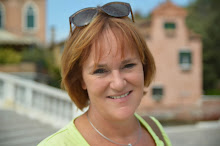- white drawing sheet
- colored sheet
- Indian ink or fine black marker
- glue
- scissors
dinsdag 15 maart 2022
Henna hands
dinsdag 26 oktober 2021
Wire portrait like Alexander Calder
During a study day on art education our teachers made portraits of wire. This can also be done in higher grades. If you want to make wire figures in lower grades, then choose a simpler shape, for example fruit/veggies or an animal.
This activity can be done in a lesson about Alexander Calder, known for his wire portraits and mobiles.
You need:
- 3 meters wire thickness 1,3 mm
- wire cutter
- printed selfie 30 by 40 cm
- black marker
- painters tape
Take a picture of yourself and print it.
Outline your face, eyes, nose, mouth and hair using the black marker. Turn the sheet over, the lines can be seen on the back of it now.
Wrap 3 m of wire around your fingers into a bunch.
Start at the neck. Lay the wire flat on the photo and follow the lines of your face. Try to lay out the portrait without cutting the wire. If this doesn't work out, you may smuggle by cutting the wire and go on with a new piece. Give the portrait more strength by doubling the wire on some places. Stick the wire now and then on the photo with painters tape.
Finished? Remove the pieces of tape. Fix the places where wire comes up by making connections with small pieces of wire. See detail photo.
donderdag 21 oktober 2021
Painting with scissors like Matisse
You need per student:
- 1 sheet white drawing paper
- 1 sheet colored construction paper
- 1 sheet colored construction paper from which you cut 7 cm
- 1 sheet blue construction paper
- leftovers of colored paper
- glue
- scissors
- black marker
Who is Matisse?
Matisse (1869 –1954) was a French artist, known for both his use of colour and his fluid and original draughtsmanship. He was primarily known as a painter.
Matisse didn't care if stones were blue, he just chose the colors he liked. Some people thought is art was very ugly: someone who paints blue faces and green noses is a fool and Matisse was called 'Fauve', which means: wild. This is how the word Fauvism came into being for this art movement, art with bold colors.
After a surgery Matisse spent the rest of his life in a wheelchair. He wasn't able to paint anymore, but could still paint with his scissors.
View various artworks of Matisse.
Then few the artwork Oasis. What stands out?
- no straigh lines
- organic shapes
- bright colors
- What is an oasis and why is this artwork called so?












